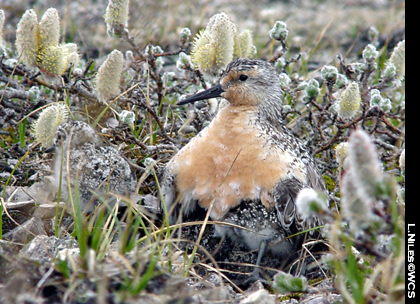Petition for emergency listing for the Red Knot

I learned today that a coalition of environmental groups, including the New Jersey Audubon, the Defenders of Wildlife, and the National Audubon Society have begun proceedings to have the rufa subspecies of the red knot, Calidris canutus, protected under the Endangered Species Act (ESA). As you know from reading previous issues of Birds in the News, red knot populations have declined globally in recent decades, and the rufa subspecies, which migrates along the east coast of the United States, has plummeted by as much as 60% since the late 1980s.
The rufa subspecies winters in Tierra del Fuego and other parts of South America, and migrates some 9,000 miles to its Arctic breeding grounds in Canada. Along the way, the birds concentrate in vast numbers at staging areas to refuel and rest, which makes them particularly vulnerable. Delaware Bay is the most important of these stop-off points, where the knots feed on the eggs of horseshoe crabs to sustain them on their long journey north.
Overharvesting of horseshoe crabs by fishermen for use as bait in conch and eel pots has been linked to these declines in red knots. This is alarming because the red knot has evolved a relatively long lifespan and a commensurately low reproductive rate. Thus, even if everything was set right today, it will take these birds a long time to recover their former numbers. Conservationists have noted that although the population still numbers in the tens of thousands, it is rapidly crashing and they predict that the red knot could become extinct in ten years if the current rate of decline continues.
ABC and National Audubon Society have led efforts to protect horseshoe crabs, and the knots and other shorebirds that rely on their eggs. These efforts appear to be paying off, as the 2004 take of crabs reached its lowest levels in more than a decade. In 2004, crab landings in Delaware Bay, a critical place for both crabs and shorebirds, fell by 53% from 2003 levels. Coastwide landings dropped to just 630,000 crabs. The US Fish and Wildlife Service will initiate a public comment period if they decide to proceed with the listing process.
======
Image source: Wildlife Conservation Society: Red Knot Migration and Horseshoe Crab Conservation in the Delaware Bay.
© 2004, 2005, 2006 by GrrlScientist











2 Peer Reviews:
and now I wonder, to whom do we petition?
The USFWS is seeking comments from the public. I will post the URL when I find it. Of course, you can also contact the agencies involved, too!
GrrlScientist
Post a Comment
<< Home